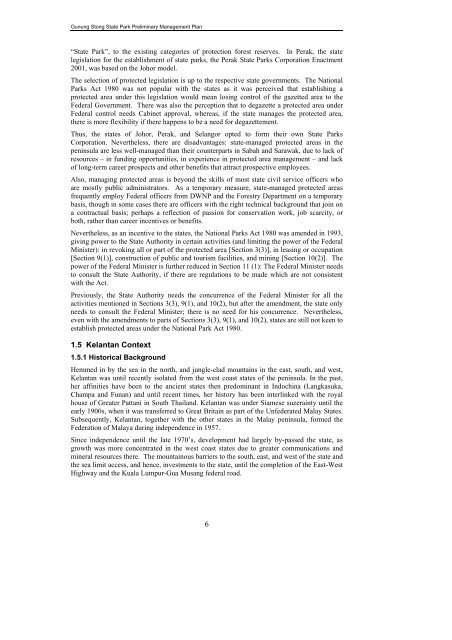FINAL VERSION FOR APPROVAL - Sdn Bhd - WWF Malaysia
FINAL VERSION FOR APPROVAL - Sdn Bhd - WWF Malaysia
FINAL VERSION FOR APPROVAL - Sdn Bhd - WWF Malaysia
You also want an ePaper? Increase the reach of your titles
YUMPU automatically turns print PDFs into web optimized ePapers that Google loves.
Gunung Stong State Park Preliminary Management Plan<br />
“State Park”, to the existing categories of protection forest reserves. In Perak, the state<br />
legislation for the establishment of state parks, the Perak State Parks Corporation Enactment<br />
2001, was based on the Johor model.<br />
The selection of protected legislation is up to the respective state governments. The National<br />
Parks Act 1980 was not popular with the states as it was perceived that establishing a<br />
protected area under this legislation would mean losing control of the gazetted area to the<br />
Federal Government. There was also the perception that to degazette a protected area under<br />
Federal control needs Cabinet approval, whereas, if the state manages the protected area,<br />
there is more flexibility if there happens to be a need for degazettement.<br />
Thus, the states of Johor, Perak, and Selangor opted to form their own State Parks<br />
Corporation. Nevertheless, there are disadvantages: state-managed protected areas in the<br />
peninsula are less well-managed than their counterparts in Sabah and Sarawak, due to lack of<br />
resources – in funding opportunities, in experience in protected area management – and lack<br />
of long-term career prospects and other benefits that attract prospective employees.<br />
Also, managing protected areas is beyond the skills of most state civil service officers who<br />
are mostly public administrators. As a temporary measure, state-managed protected areas<br />
frequently employ Federal officers from DWNP and the Forestry Department on a temporary<br />
basis, though in some cases there are officers with the right technical background that join on<br />
a contractual basis; perhaps a reflection of passion for conservation work, job scarcity, or<br />
both, rather than career incentives or benefits.<br />
Nevertheless, as an incentive to the states, the National Parks Act 1980 was amended in 1993,<br />
giving power to the State Authority in certain activities (and limiting the power of the Federal<br />
Minister): in revoking all or part of the protected area [Section 3(3)], in leasing or occupation<br />
[Section 9(1)], construction of public and tourism facilities, and mining [Section 10(2)]. The<br />
power of the Federal Minister is further reduced in Section 11 (1): The Federal Minister needs<br />
to consult the State Authority, if there are regulations to be made which are not consistent<br />
with the Act.<br />
Previously, the State Authority needs the concurrence of the Federal Minister for all the<br />
activities mentioned in Sections 3(3), 9(1), and 10(2), but after the amendment, the state only<br />
needs to consult the Federal Minister; there is no need for his concurrence. Nevertheless,<br />
even with the amendments to parts of Sections 3(3), 9(1), and 10(2), states are still not keen to<br />
establish protected areas under the National Park Act 1980.<br />
1.5 Kelantan Context<br />
1.5.1 Historical Background<br />
Hemmed in by the sea in the north, and jungle-clad mountains in the east, south, and west,<br />
Kelantan was until recently isolated from the west coast states of the peninsula. In the past,<br />
her affinities have been to the ancient states then predominant in Indochina (Langkasuka,<br />
Champa and Funan) and until recent times, her history has been interlinked with the royal<br />
house of Greater Pattani in South Thailand. Kelantan was under Siamese suzerainty until the<br />
early 1900s, when it was transferred to Great Britain as part of the Unfederated Malay States.<br />
Subsequently, Kelantan, together with the other states in the Malay peninsula, formed the<br />
Federation of Malaya during independence in 1957.<br />
Since independence until the late 1970’s, development had largely by-passed the state, as<br />
growth was more concentrated in the west coast states due to greater communications and<br />
mineral resources there. The mountainous barriers to the south, east, and west of the state and<br />
the sea limit access, and hence, investments to the state, until the completion of the East-West<br />
Highway and the Kuala Lumpur-Gua Musang federal road.<br />
6
















